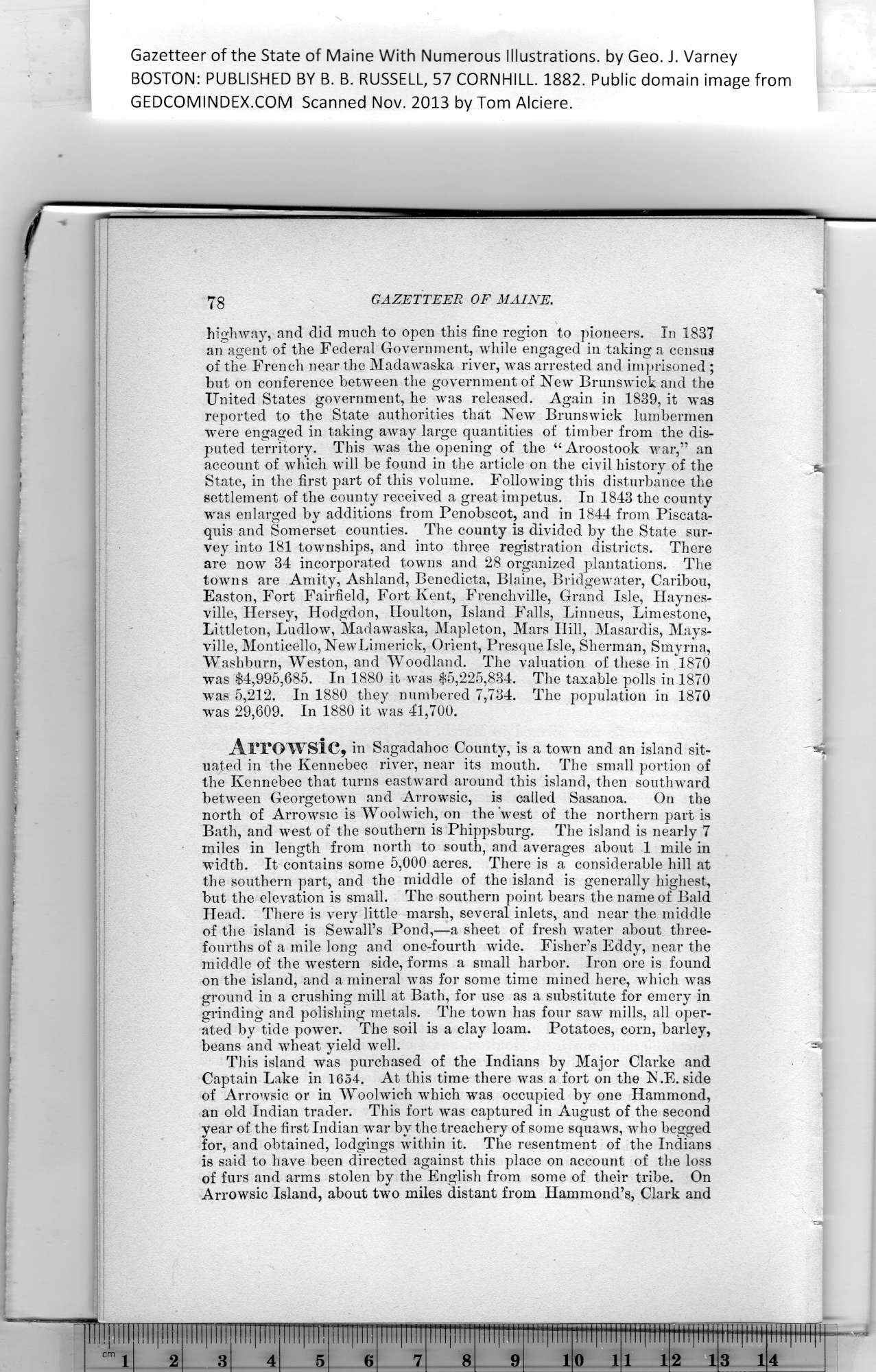|
Gazetteer of the State of Maine With Numerous Illustrations, by Geo. J. Varney
BOSTON: PUBLISHED BY B. B. RUSSELL, 57 CORNHILL. 1882. Public domain image from
78 GAZETTEER OF MAINE.
highway, and did much to open this fine region to pioneers. In 1837
an agent of the Federal Government, while engaged in taking a census
of the French near the Madawaska river, was arrested and imprisoned ;
but on conference between tbe government of New Brunswick and the
United States government, he was released. Again in 1839, it was
reported to the State authorities that New Brunswick lumbermen
were engaged in taking away large quantities of timber from tbe dis-
puted territory. This w'as the opening of the “ Aroostook war,” an
account of which will be found in the article on the civil history of the
State, in the first part of this volume. Following this disturbance the
settlement of the county received a great impetus. In 1843 the county
was enlarged by additions from Penobscot, and in 1844 from Piscata-
quis and Somerset counties. The county is divided by the State sur-
vey into 181 townships, and into three registration districts. There
are now 34 incorporated towns and 28 organized plantations. The
towns are Amity, Ashland, Benedicta, Blaine, Bridgewater, Caribou,
Easton, Fort Fairfield, Fort Kent, Frenchville, Grand Isle, Haynes-
ville, Hersey, Hodgdon, Houlton, Island Falls, Linneus, Limestone,
Littleton, Ludlow, Madawaska, Mapleton, Mars Hill, Masardis, Mays-
ville, Monticello, NewLimerick, Orient, Presque Isle, Sherman, Smyrna,
Washburn, Weston, and Woodland. The valuation of these in .1870
was $4,995,685. In 1880 it was $5,225,834. The taxable polls in 1870
was 5,212. In 1880 they numbered 7,734. The population in 1870
was 29,609. In 1880 it was 41,700.
Arrowsic, in Sagadahoc County, is a town and an island sit-
uated in the Kennebec river, near its mouth. The small portion of
the Kennebec that turns eastward around this island, then southward
between Georgetown and Arrowsic, is called Sasanoa. On the
north of Arrowsic is Woolwich, on tbe'west of the northern part is
Bath, and west of tbe southern is Phippsburg. The island is nearly 7
miles in length from north to south, and averages about 1 mile in
width. It contains some 5,000 acres. There is a considerable hill at
the southern part, and the middle of the island is generally highest,
but the elevation is small. The southern point bears the name of Bald
Head. There is very little marsh, several inlets, and near the middle
of tbe island is Sewall’s Pond,—a sheet of fresh water about three-
fourths of a mile long and one-fourth wide. Fisher’s Eddy, near tbe
middle of the western side, forms a small harbor. Iron ore is found
on the island, and a mineral was for some time mined here, which was
ground in a crushing mill at Bath, for use as a substitute for emery in
grinding and polishing metals. The town has four saw mills, all oper-
ated by tide power. The soil is a clay loam. Potatoes, corn, barley,
beans and wheat yield wrnll. -
This island was purchased of the Indians by Major Clarke and
Captain Lake in 1654. At this time there was a fort on the N.E. side
of Arrowsic or in Woolwich which was occupied by one Hammond,
an old Indian trader. This fort was captured in August of the second
year of the first Indian war by the treachery of some squaws, who begged
for, and obtained, lodgings within it. The resentment of tbe Indians
is said to have been directed against this place on account of the loss
of furs and arms stolen by the English from some of their tribe. On
Arrowsic Island, about two miles distant from Hammond’s, Clark and
PREVIOUS PAGE ... NEXT PAGE
This page was written in HTML using a program written in Python 3.2
|
